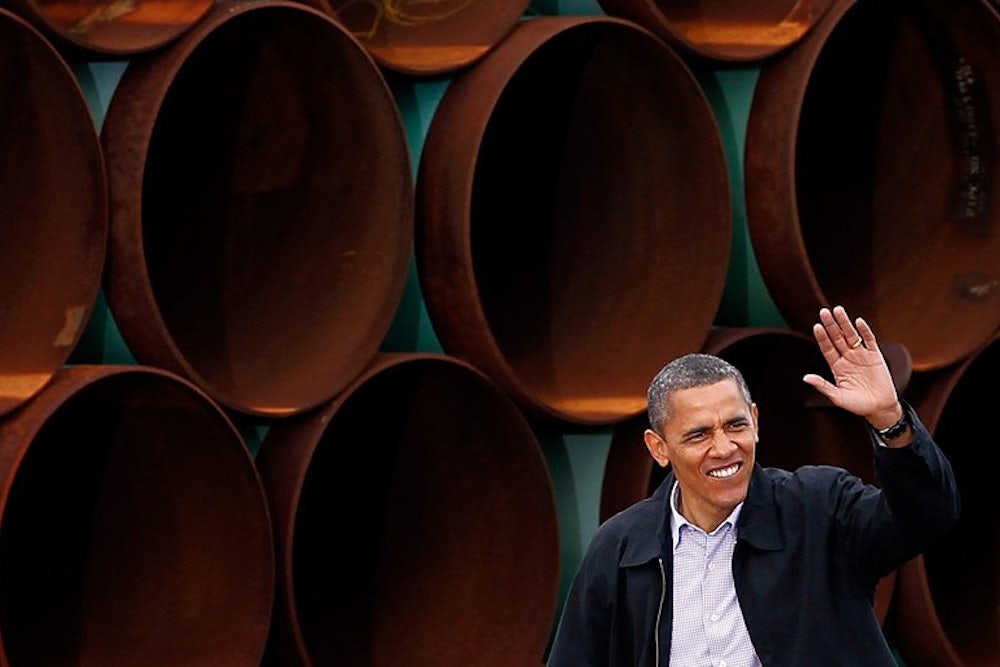In his second inaugural address, President Obama evoked the highest possible authority in stating his commitment to the global environment:
We will respond to the threat of climate change, knowing that the failure to do so would betray our children and future generations. … The path to sustainable energy sources will be long and sometimes difficult. But America cannot resist this transition; we must lead it. … That is how we will preserve our planet, commanded to our care by God.
As Mario Cuomo famously remarked, however, we campaign in poetry, but we govern in prose. And the period of environmental prose has begun for Obama, in the form of a 2000-page "Draft Supplemental Environmental Impact Statement" for the hotly debated Keystone XL pipeline, which would link oil produced from tar sands in Alberta, Canada and Montana to existing pipelines in southeastern Nebraska. The president now faces a momentous choice, albeit one whose symbolic force and political consequences exceed its impact on the global climate. Fortunately, there does seem to be a way that Obama can extricate himself from the dilemma.
This new report makes it clear that the project has been revised significantly since the initial request was rejected in 2011: The pipeline’s new proposed route is more than 500 miles shorter than the original and was altered to avoid environmentally sensitive areas in Nebraska’s Sand Hills region. Although there are residual domestic environmental concerns and risks that the various parties to the dispute assess differently, the heart of the remaining debate is the effect of the pipeline’s construction on the rate at which Canadian oil sands are developed for extraction of heavy crude. This matters because, as the draft report states, the oil from this source generates more greenhouse gases, all things considered, than does the average barrel of heavy crude now refined in the United States. The report puts the difference at 17 percent; some other estimates are significantly higher.
In what may be its single most important sentence, the report states that “Approval or denial of any one crude oil transport project, including the proposed Project, remains unlikely to significantly impact the rate of extraction in the oil sands, or the continued demand for heavy crude oil at refineries in the U. S.” The report argues that railroads offer a feasible (if more expensive) transportation option, and that the oil industry will develop alternative pipeline routes in the event that Keystone project does not go forward.
Environmental groups strongly disagree with this assessment, and industry leaders are divided. A recent article in Bloomberg Businessweek argues that “Stopping the pipeline would mean continued discounted prices for Canadian crude, making it harder for producers to sell their commodity at a profit and potentially slowing oil-sands development.” Canadian heavy crude prices have declined because a lack of export capacity has generated a glut, forcing producers to offer discounts of almost $30 per barrel. Said one energy company CEO, “If we can’t attract world prices, then we will ultimately curb energy development.”
It’s not clear how much any of this would matter in the long run. Although environmentalists hope to stifle the extraction of heavy crude from oil sands permanently, the State Department report does not believe that outcome is feasible, and neither do Canadian officials. The report estimates that suppressing all new pipelines—not only Keystone but other Canadian and U.S. alternatives—would reduce production from oil sands by only 2 to 4 percent in 2030. If Keystone were halted while other proposed pipeline projects proceed, the effect would be even less—0.4 to 0.6 percent. The impact on climate change would be undetectable.
Canada's oil sands are estimated to hold 170 billion barrels, a total that could rise sharply as extraction technologies improve. Given the economic stakes for Canadians, it is hard to believe that a negative answer from us would stop their progress. Indeed, the State Department’s assessment seems more plausible than that of major environmental organizations: The fate of the Keystone pipeline will have a short-term impact on Canada, but in the long run, “Fundamental changes to the world crude oil market … would be required to significantly impact the rate of production in the oil sands.” In that way, the principal policy effect of turning down Keystone would be the souring of relations with Canada, whose senior officials would regard it as a capitulation to U.S. political considerations at their expense.
The State Department report will make it much harder for Obama to justify rejecting the Keystone project. Still, it has become a highly visible and emotionally charged symbol of an often diffuse issue, and it is where many leading environmental organizations have chosen to draw the line. If the president were to proceed with Keystone, millions of his supporters would regard his decision as an outright betrayal. So what is he to do?
Obama is in this fix in part because he raised the stakes after the 2012 election and largely because Keystone is the first major environmental decision of his second term. But what if it weren’t? There are other decisions that he could make that would have a far greater impact on greenhouse gas emissions.
For example, the president could announce that because Congress had failed to act in more than four years to curb climate change, he would rely on his executive authority to do so, just as he pledged during his 2013 State of the Union address. One possibility is for the EPA to unveil new initiatives to accelerate the closure of high-emission coal-fired power plants—before Obama announces his position on Keystone. And those actions would then frame the Keystone decision and mute its negative political impact. That may be the only way to avoid having this long-delayed and over-hyped project end up as a political disaster.
